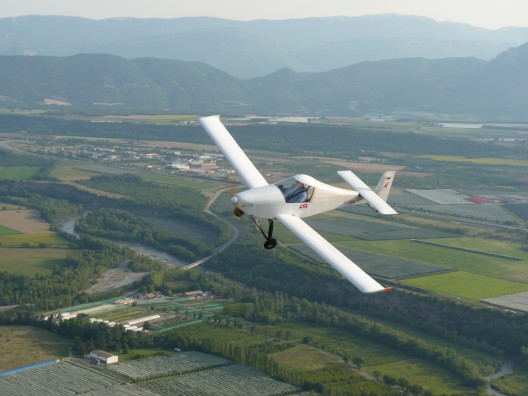One highly enjoyable aspect of writing this blog is waking up in the morning to emails from France, announcing some exciting developments for those who love small aircraft.
Fabrice Tummers from Luxembourg Special Aerotechnics (LSA) and Anne Lavrand from Electravia alerted your editor to a cooperative venture in which they swapped out the original Eck/Geiger motor/controller and Helix propeller combination (with which the airplane set a class speed record) on LSA’s MC-30e Luciole (Firefly) for an Electravia power package.
Since many of the Michel Colomban-designed MC-30s are powered by a Briggs & Stratton V-twin that produces about 26 horsepower, the new electric motor setup provides a great opportunity to compare electric and internal combustion performance.
It should be a fair comparison, with the empty weight of the MC-30e with batteries registering a European legal ultralight 113 kilograms (248.6 pounds).
The new system includes a 26-horsepower E-Motor GMPE 102 (motor and controller), a two-bladed E-Props wooden propeller, and a Kokam rechargeable battery pack. Batteries have a 4.7 kilowatt hour capacity, an Electravia battery management system (BMS) and protection circuit module (PCM). Their 33 kilograms can produce a 55-minute flight in relative silence (52 dBA measured).
Operations are monitored by dedicated instrumentation on an organic light emitting diode (OLED) display that allows clear reading even in bright sunlight. Flight and system performance are gathered and stored in a data logger.
Electravia designed and manufactured a new cowling and propeller spinner to minimize form drag and optimize the cooling of the powertrain.
Electravia notes, somewhat cryptically that, “Compared to standard Electravia systems, the engine (motor) of this device has characteristics that are not described here.”
Perhaps some of these characteristics account for the sprightly performance of the newly powered craft, piloted during the tests by Jean-Luc Soullier, founder, manager and test pilot for LSA. Tests held between August 1 and August 3, 2011 resulted in seven flights that revealed a climb rate of six meters per second (1,181 feet per minute) a maximum level flight speed of 220 kilometers per hour (119 knots or 136.85 miles per hour), and a takeoff run of 62 meters (189 feet).
Noise level at takeoff is a mere 52 dB/A, and a pass at 150 meters (480 feet) over the Sisteron airfield is virtually silent, the aircraft being quieter than the ambient noise on the open field. As Anne Lavrand writes, “You can ‘hear the silence’ on the… video. It is very surprising, even for us. The propeller is great.”
Electravia compares these results to a combustion engine Firefly with the same stated horsepower:
– The rate of climb increases by 41%.
– The maximum speed increases by 10%.
– Take-off distance decreases by 38%.
– The noise level at take-off is 61 dBA (for the IC version) and 52 dBA (or – 9 dBA) for the electric.
Ms. Lavrand promises a new test campaign with new equipment in September and explains the Firefly “is a successful bench test allowing the development of numerous innovations which will then be run on the other aircraft of the company LSA, in cooperation with Electravia.”
The statement is fraught with promise of new developments and new, exciting morning emails.
(Note: Entry corrected August 7 with input from Fabrice Tummers and Howard Handelman.)


Comments 2
Good article, but I guess it depends what you mean by “the same horsepower”! That extra climb rate is worth 2.59 THP or perhaps 3 BHP out of 26 or 11.7%. The change in maximum speed should be worth no less than 15%, very roughly estimated.
(Editor’s Note: Good catch. It might have been advisable to say, “stated horsepower.” Older pilots will remember that the Continental 65-horsepower engine made a Piper Cub climb 40 feet per minute faster than a 65-horsepower Lycoming.)
Hello,
Max climb rate:
** With 4-strocke engine as Briggs & Stratton 26 HP : 4,25 m/sec [837 ft/mn]
** With this electric engine 26 HP : 6 m/sec [1.181 ft/mn]
Seems correct –> value increases of 41%
Great experimentations! Congralutations to Soullier from LSA, Luxembourg! Let’s go electric pioneers!